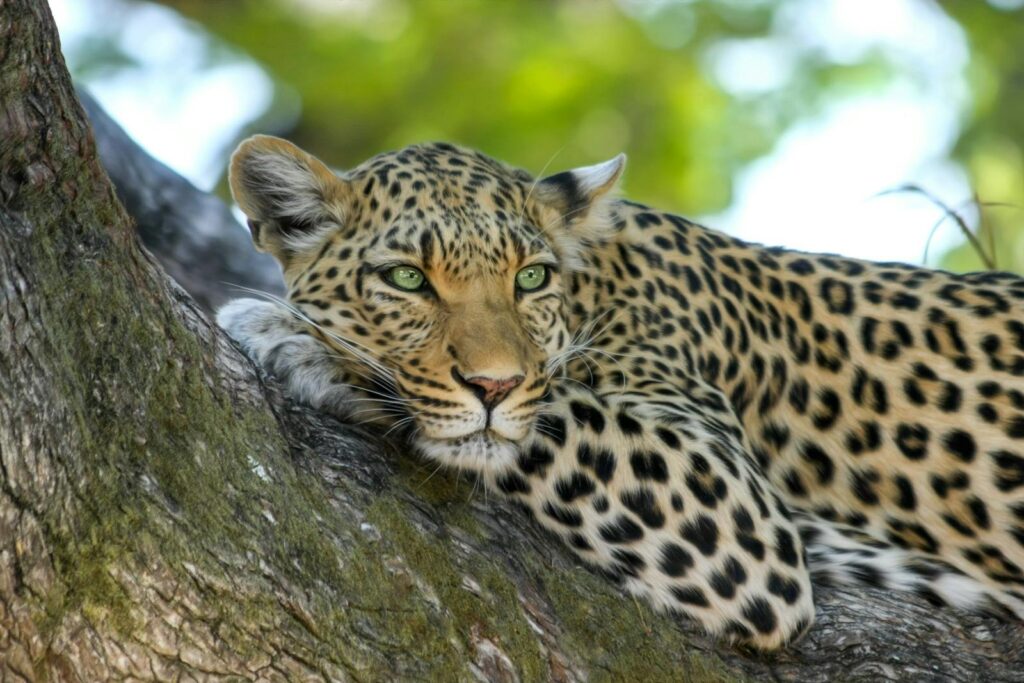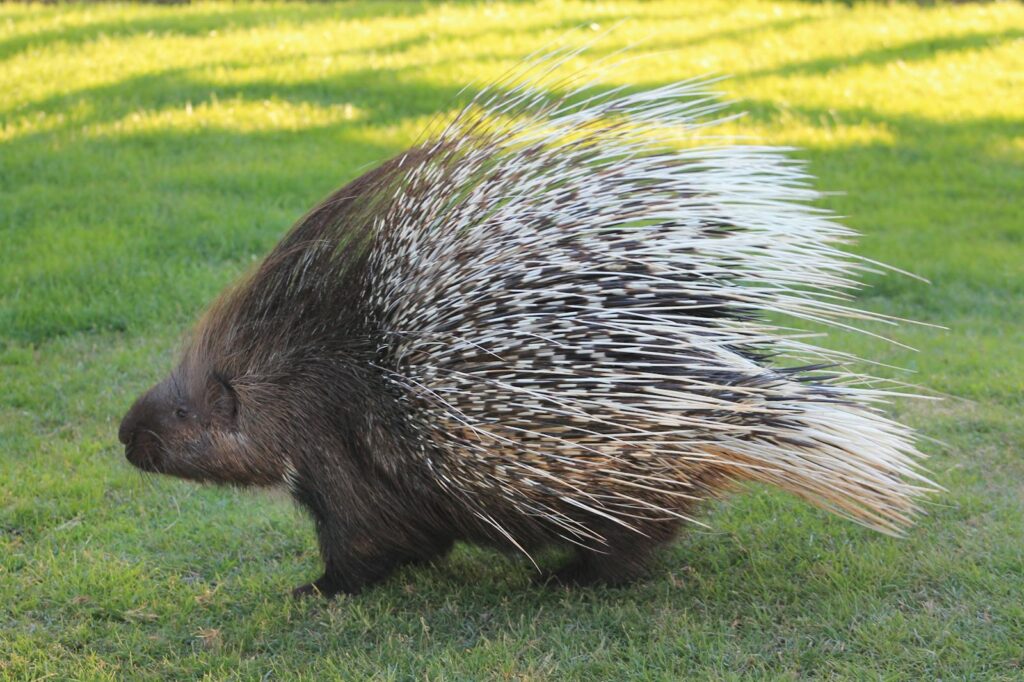In the wild, life unfolds unpredictably, shaped by the relentless struggle for survival. A recent incident in Kruger National Park highlights the stark realities of predator-prey dynamics, featuring a tense confrontation between a hungry leopard and a tenacious porcupine. This encounter prompts reflection on the instinctual roles of both creatures, as well as the broader themes of resilience and adaptability that define the animal kingdom. Such moments serve as poignant reminders of nature’s complexities and the delicate balance that sustains ecosystems, making us appreciate the intricate dance of survival.
The leopards and the porcupines have their own characteristics and advantages respectively.
As the scene unfolds, the leopard, a master of stealth and speed, epitomizes the quintessential predator. With the ability to reach speeds of up to 40 miles per hour, leopards are formidable hunters, employing a combination of strength and cunning to secure their meals. However, not all hunts are successful, as illustrated by this particular encounter. Leopards are known for their brutal bite, often targeting the softest parts of their prey. Yet, in this scenario, they are met not with a vulnerable animal but with a creature armed with an extraordinary defense mechanism: sharp quills.
Porcupines, often underestimated due to their slow gait and seemingly awkward demeanor, bear a unique adaptation that protects them from predators. Their quills, modified hairs that can easily detach and embed in the skin of an attacker, serve as a painful deterrent. These spiny defenses are a testament to nature’s ingenuity, allowing the porcupine to protect itself while allowing it the freedom to roam its habitat. The video capturing this tense standoff reveals how the porcupine mother positioned herself strategically, ensuring her young were shielded from the leaping leopard.
A leopard struggled with a porcupine: a hard process.
The drama escalates as the leopard, undeterred by the presence of sharp quills, attempts to close in on its quarry. Each pounce is met with a defensive display from the porcupine—a rotating movement that raises its quills in warning. The porcupine’s behavior exemplifies an instinctual response that has evolved over millennia. Often silent creatures, porcupines can communicate their distress through deep grunts, which in this case rang out loud and clear as the leopard approached. This vocalization served as a warning not only to the immediate threat but also resonates with the instinctual behavior of many animals in distress.
It’s fascinating to observe how animal behaviors interweave during these life-and-death situations. The leopard, embodying raw determination, strategically circles its prey, looking for any opportunity to exploit a weakness. In contrast, the porcupine remains steadfast, using its quills not just as a weapon but as a shield. This interplay of offensive and defensive strategies highlights the complex dance of predator and prey that plays out across the savanna.
Hours can seem like mere moments during such encounters, and as tensions heightened, it became evident that this was not going to be a straightforward hunt for the leopard. Wildlife photographer Callum Perry, who documented this encounter, captured the essence of an age-old story: the struggle for survival. His commentary encapsulates the essence of this brutal ballet: “This leopard was made to work for his lunch when he came across this prickly customer.” Such artistry in the wild compels us to confront nature’s truth—every success is often accompanied by struggle.
As the leopard tries to find an angle that would give it the advantage, each failed pounce becomes a lesson in perseverance. In the animal kingdom, failure is merely a stepping stone to adaptation. As the porcupine raises its quills time and again, it serves as a reminder that defense mechanisms are just as vital as predatory strategies in the wild. This moment illuminates not only the tenacity of the leopard but also the resilience of the porcupine, who remains resolute against a relentless foe, showcasing the incredible survival tactics of both animals.
After several minutes of what can only be described as a fierce showdown, the leopard ultimately retreats, recognizing the futility of its attempts against such a well-defended opponent. The porcupine family, their instincts guiding them, safely continues their journey, embodying a victorious narrative that speaks volumes about survival against the odds. The leopard may have left without a meal, but it left with lessons learned—nature’s own school of hard knocks.

People can get a better understanding of nature and wild animals through this struggle.
This encounter is a vivid illustration of how even the mightiest predators must sometimes bow to the ingenious defenses of their prey. The harsh realities of nature often serve as a reminder of the delicate balance that exists within ecosystems. In the wild, every creature plays a role, and each interaction contributes to the broader tapestry of life.
The resilience showcased in moments like these serves as a crucial reminder that we share this beautiful land with a diverse array of wildlife, each with their unique adaptations and survival strategies. It is vital to protect these dynamics, as they are fundamental to maintaining the intricate balance of our natural world. As viewers, we are left not only awestruck by the drama that unfolded but also educated on the essential roles each species plays in the ecosystem. These encounters deepen our understanding and commitment to wildlife conservation.
The wild is a place of beauty and brutality, where survival hinges on both strength and strategy. The confrontation between the leopard and porcupine is a microcosm of the challenges faced by wildlife daily. It serves as an invitation for us to observe, learn, and appreciate the relentless spirit of nature. Moments like these are fleeting, yet they echo in the hearts of those who witness them, reminding us of the unyielding spirit of life that flourishes amidst adversity. As we reflect on this remarkable episode, we must commit ourselves to cherish and protect the natural world that continues to inspire us.
In the wake of the encounter between the hungry leopard and the formidable porcupine, the aftermath reveals profound lessons about resilience, the instinct for survival, and the intricate dynamics of predator and prey relationships in the wild. This dramatic event, captured in vivid detail by wildlife photographer Callum Perry, not only showcases the fierce determination of the leopard but also the unwavering defense mechanisms employed by the porcupine, highlighting the essence of nature’s intricate balance.
As spectators, we often marvel at the raw beauty of wildlife, but this encounter serves as a stark reminder that nature is a relentless arena where survival often hinges on a series of critical decisions made in mere moments. The leopard, driven by its instinctual need to hunt and feed, displayed a remarkable tenacity, circling its prey and attempting multiple pounces, each met with the spiky defense of the porcupine. This scenario illustrates the ancient struggle for existence—the predator, determined to secure its sustenance, and the prey, equally resolved to evade the jaws of death, highlighting the perpetual battle for survival.
One of the most striking aspects of this encounter is the sheer tenacity displayed by both animals. For the leopard, this was not just a hunt; it was a test of strategy and patience. Known for its strength and agility, the leopard is typically an adept hunter. Yet, faced with the formidable defenses of a porcupine, it was forced to innovate and adapt its hunting strategy. The repeated attempts to find a weak point in the porcupine’s defenses exemplify the lengths to which predators will go when confronted with challenges. Each failed pounce not only showcased the leopard’s resilience but also underscored the importance of adaptability in the animal kingdom.
Conversely, the porcupine’s defensive tactics were nothing short of remarkable. With its quills raised and its body positioned strategically, the porcupine demonstrated a deep-seated instinct for self-preservation. It serves as a powerful example of how prey animals can evolve defenses that are not only effective but also rooted in their biology. The ability to raise quills as a warning signals not just a physical response but also a behavioral adaptation that has allowed porcupines to thrive in environments where predators like leopards hunt. This battle of wits and instincts is a testament to the ongoing evolutionary arms race in nature, where each species must continuously adapt to survive, showcasing the brilliance of natural selection.
As the dramatic showdown unfolded, it became evident that this was more than just a physical confrontation; it was a rich narrative woven into the fabric of ecological balance. The leopard’s retreat, after realizing the futility of its attempts, speaks volumes about the lessons learned in the wild. Nature is not solely about brute force; it is also about recognizing one’s limitations and adapting to the resources available. The leopard left this encounter without a meal but gained valuable insights into the resilience of its prey.
Furthermore, the dynamics observed in this encounter resonate beyond the immediate participants. They reflect broader ecological principles that are essential for maintaining balance within ecosystems. Predators like leopards play a crucial role in controlling prey populations, while prey species must continuously adapt their defenses to survive. This interaction contributes to the health of the ecosystem, ensuring that various species can coexist and thrive in a delicate balance. The leopard’s failure to capture the porcupine may initially seem like a loss, but it ultimately enriches the ecological narrative by allowing the porcupine to continue its lineage and pass on its successful adaptations to future generations.
The implications of this encounter extend into the realm of conservation and wildlife management. By understanding the intricacies of predator-prey dynamics, conservationists can better appreciate the need to protect both predators and prey. Each species, no matter how seemingly insignificant, contributes to the overall health of the ecosystem. The leopard and porcupine, through their encounter, remind us of the interconnectedness of life and the importance of preserving these relationships.
As we reflect on the aftermath of this extraordinary encounter, we are left with a profound appreciation for the wild. It is a realm where every moment is imbued with purpose, where survival is a testament to resilience and adaptability. The leopard’s experience serves as a lesson in humility, reminding us that even the most skilled hunters can learn and grow from their encounters. It is a narrative that encourages us to embrace the wild spirit of nature, recognizing that every interaction, every struggle, and every moment of triumph is part of the grand tapestry of life, enriching our connection to the natural world.

The story of the leopard and the porcupine serves as a poignant reflection of the intricate dynamics within ecosystems. It highlights the necessity of adaptability and the resilience found in all forms of life. Observing such interactions invites us to connect with nature—encouraging us to listen, learn, and commit to protecting the delicate web of life that captivates us. This narrative enriches our understanding of wildlife while reminding us of our shared responsibility to preserve the natural world that sustains us. By embracing these lessons, we can ensure that future generations will also experience the remarkable stories woven throughout our ecosystems, fostering a deeper appreciation for the environment.
Related posts:
Incredible: Porcupine parents fend off hungry leopard trying to eat their babies
Leopard gets covered with thorns while hunting porcupine. Here’s who won
Porcupine continually deflects a hungry leopard with its razor sharp quills in tense standoff




:max_bytes(150000):strip_icc()/121024-MarthaStewart-Lead-f56da21a28a04ba895a93b9a987a2e76.jpg)